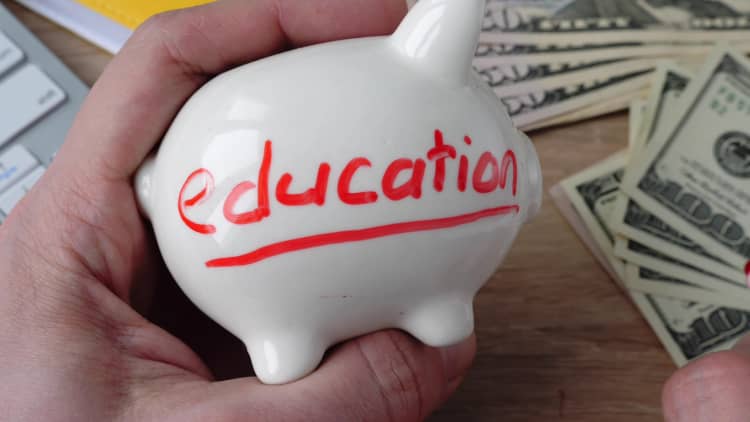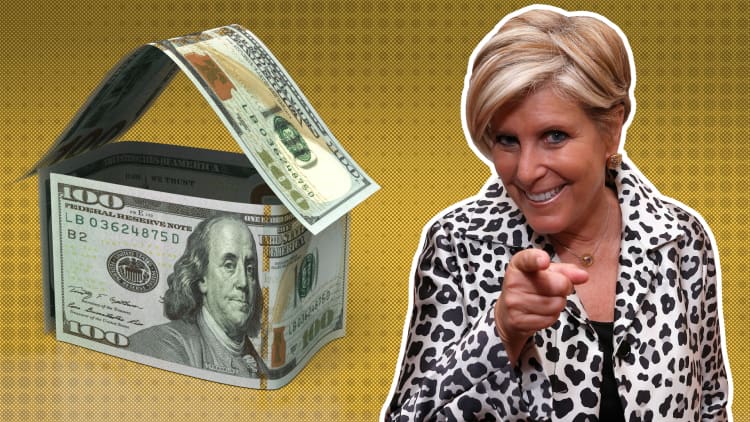Paying off thousands of dollars in student loan debt is no easy task. But Justine Nelson, founder of financial resource site Debt Free Millennials, makes the whole thing seem strangely simple.
Nelson, 31, paid off $35,000 in student loan debt, including interest, within 2.5 years, starting in Nov. 2011 and ending in April 2014.
Although Nelson says she gave herself a five year timeline to pay off her debt, she managed to finish early and officially eliminated her student loans in two years and five months. During that time, she changed jobs twice and earned $37,000 per year on average.
To reach her goal of becoming debt-free, Nelson says she had to get motivated, make sacrifices and find strategies to keep her morale high and boost her confidence until the day her debt hit $0.
One phone call changed Nelson's financial future
Nelson didn't always expect to be on a debt journey post-college. When she chose to enroll at Kansas State University as a marketing major, she thought her tuition would be covered by her parents.
However, in 2008, during Nelson's sophomore year of college, her mom was laid off after working 25 years at Sprint and informed Nelson that she'd have to finance the rest of her education herself.
"She called and said she and my dad could no longer support me financially through school ... and that I would have to find a job, take out loans and try to make it work," Nelson says.
I was thinking I was the only one who was struggling financially and I didn't know how to communicate that to my friends.Justine NelsonFounder, Debt Free Millennials
Nelson hung up the phone a fully financially independent person and almost immediately began to notice a difference in how she related to her peers and classmates, especially those living in her sorority house with her. "I was thinking I was the only one who was struggling financially and I didn't know how to communicate that to my friends," Nelson says.
To cover her rent, Nelson got a part-time job as a waitress at Chili's and to cover tuition, she took out loans. "I ended up doing what a lot of other college students do, which is take out more money ... more loans," Nelson says.
After graduating in 2011, Nelson took a marketing internship that paid just $10 an hour and quickly realized she wouldn't be able to pay off the $30,000 she owed in loans (before interest), plus another $3,000 she owed to a family member who had helped her pay for a study abroad trip, while also covering her everyday living costs.

As a result, Nelson moved home to her parents' house in Shawnee, Kansas, in order to save money. The move was a wake-up call for Nelson: Living back under her parents' roof majorly motivated her to tackle her debt.
"My 'aha!' moment was living back home in the same bedroom that I grew up in with my parents," Nelson says. "I had dreams to live downtown in an urban apartment. I wanted to live in the city and go to the happy hours and travel internationally. And I knew that I wouldn't be able to do that quickly if I still had the debt."
The strategies that helped Nelson pay off her loans
Full of jealousy toward her friends who could afford to live more lavishly, and, frankly, "pissed off" about her situation, Nelson says she decided to create new rules — and establish a real plan for ridding herself of her loans.
After "working her butt off" at her $10-an-hour summer internship, Nelson's company offered her a full-time position in the fall of 2011, which paid $33,000 annually. In January 2013, she landed a new job as a client manager for the Kansas State University Division of Communications and Marketing that paid $41,000 annually.
Once she was earning more than $10 an hour, Nelson began prioritizing the order in which she'd attack her loans. She used the "debt snowball" method, which is a repayment strategy in which you pay off your debts in order from the smallest amount to the largest. This strategy is known for its confidence-boosting effects, since it allows you to completely eliminate whole portions of debt right away.
Nelson first paid back her cousin, who had loaned her $3,000 to study abroad while in college. Paying that off took around three months, Nelson says. Then, she mapped out a repayment plan for the rest of her student loans and started "tackling them one by one."
The snowball method worked for me because I loved the instant gratification of paying off a smaller loan. That quick win gave me confidence that I could pay off the next loan quickly.Justine NelsonFounder, Debt Free Millennials
The amount she paid back per month "fluctuated a lot," Nelson says. If she was going on vacation, for instance, she'd sometimes put only a few hundred dollars toward her loans in a given month. Other times, she'd pay as much as $1,100.
One trick that helped Nelson was to make manual loan payments instead of automated ones, since she was responsible for a number of different loans, including many from the same lender. That meant going into her loan dashboard and entering exactly how much she wanted to put toward a specific loan, rather than letting the loan issuer divide up her payment across her loans as it saw fit.
"With issuers like the Department of Education, you probably have 20 different loans you're paying on, and they'll want you to disperse your one payment across all of those loans," Nelson explains. "Instead of doing that, I would just make a manual payment toward the loan that I wanted to pay off first."
This made it possible for Nelson to stick to her plan and pay off the entirety of her smallest loans first. "The snowball method worked for me because I loved the instant gratification of paying off a smaller loan," she says. "That quick win gave me confidence that I could pay off the next loan quickly."
She also allowed herself small celebratory moments along the way, such as when she paid back her cousin and when she'd paid off half of her loans, in order to stay motivated: "I built in mini rewards along the way. When I paid off a loan, I rewarded myself with a pedicure and gave myself permission to spend on vacations."
In addition to using the snowball method, Nelson says "writing everything down" was a crucial step in her debt journey.
"This is the No. 1 tool that helped me," she says. "I think a lot of the financial overload comes from not looking at your financial situation. Wherever you have to track it ... whether it's an app, a spreadsheet or a whiteboard on your refrigerator ... start tracking every single expense and income, and that will help you pay off the debt."
To do this, Nelson created a budget in Google Spreadsheets, where she wrote down every dollar she made and spent. It allowed her to see where her money was going and if there were any wasteful ways she was spending that could be going toward her loans instead.
These strategies paid off: In April 2014, at 25, Nelson made her final loan payment, officially eliminating her debt.
Nelson's debt-free life
Nelson now lives in San Diego, California, with her husband Kyle, 33. He's an engineer and she runs her own full-time business: Debt Free Millennials, an online resource featuring financial courses and money advice for young people.
Through her website, blog and YouTube channel, Nelson candidly shares her story for the purpose of helping others conquer their debt and get ahead financially. In particular, she gears her efforts toward millennials — hence her company name — in order to help those in her age group deal with common financial struggles, such as "sky-high college tuition fees" and low wages.
In her free time, Nelson loves to travel. And now that she's eliminated her student loan debt, she doesn't feel bad about splurging on pricier options.
"During my debt-free journey, I still made it a priority to travel — it was still important to me," she says. "But once I became debt-free, I could afford to do it in ways that weren't as frugal. I could opt for the better airline ticket that was nonstop versus making all of these transfers. I could afford better accommodations or a nicer hotel."
In a recent Instagram post, Nelson writes: "The best part about becoming debt free? I get to travel more often!"
Don't miss: This single mom paid off $77,281 of debt in eight months—here are 5 steps she followed
Like this story? Subscribe to CNBC Make It on YouTube!



